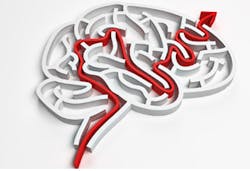Software automates brain image analysis
A startup company from Oxford University (Oxford, UK) has developed software that analyzes CT scans from stroke victims, putting the expertise of a stroke assessment team into the hands of any doctor in an emergency room.
Brainomix' (Oxford, UK) so-called e-ASPECTS software automates the Alberta Stroke Program Early CT Score (ASPECTS) pioneered by Alastair Buchan, Professor of Stroke Medicine and Head of the Medical Sciences Division at the university to identify and quantify signs of stroke.
Over the last 12 years, ASPECTS has been adopted worldwide. The original ASPECTS system relies on a scoring system to assess the CT scans but requires a stroke expert to gauge the images.
The automated e-ASPECTS system, on the other hand, encapsulates the expertise of Professor Buchan and his team in software that automatically analyses of the CT images, giving a score that can be used by any doctor to assist in deciding on what intervention should be used to treat a patient.
Professor Buchan initially developed ASPECTS to enable objective stroke assessment using CT scanning instead of using the more expensive, time consuming and less accessible magnetic resonance imaging.
Start-up Brainomix is led by Managing Director, Dr. Michalis Papadakis, along with co-founders Professors Iris Grunwald and Alastair Buchan.
Related articles from Vision Systems Design that you might also find of interest.
1. Spectroscopy aids brain tumor detection
UK researchers have shown that infrared and Raman spectroscopy - coupled with statistical analysis - can be used to differentiate between normal brain tissue and different tumor types.
2. MRI maps the development of the brain
Working in collaboration with colleagues in South Korea, scientists at Nottingham University (Nottingham, UK) aim to create a detailed picture of how the Asian brain develops, taking into account the differences and variations which occur from person to person.
3. Imaging technique detects brain cancer
University of Oxford (Oxford, UK) researchers have developed a contrast agent that recognizes and sticks to a molecule called VCAM-1 that is present in large amounts on blood vessels associated with cancer that has spread to the brain from other parts of the body.
4. Ultraviolet camera images the brain
Researchers at Cedars-Sinai Medical Center (Los Angeles, CA, USA) and the Maxine Dunitz Neurosurgical Institute are investigating whether an ultraviolet camera on loan from NASA's Jet Propulsion Laboratory could help surgeons perform brain surgery more effectively.
-- Dave Wilson, Senior Editor, Vision Systems Design
